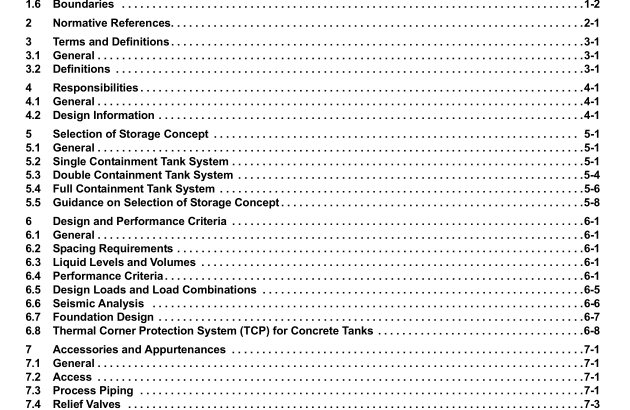API STD 625:2010 pdf free download.Tank Systems for Refrigerated Liquefied Gas Storage
.2 Design Information
4.2.1 Information by Purchaser
The Purchaser shall provide the following information:
1) scope of work for contractor (including items determined in 4.2.3);
2) tank type (see Section 5);
3) net working capacity;
4) tank location on plot plan;
5) environmental data (including, minimum/maximum ambient temperatures);
6) site geotechnical and seismic data (including soil properties, allowable soil bearing, predicted settlements after soil remediation, and foundation type selected);
7) process flow diagrams (PFDs), piping & instrumentation diagrams (P&IDs);
8) properties of the stored product, including density at the design temperature, toxicity, and flammability;
9) design pressure/vacuum, maximum/minimum operating pressure;
10) high/low pressure alarm set point;
11) design boil-off rate (as per 6.4.4);
12) minimum design temperature of primary containment;
13) natural environmental loads (such as earthquake, wind);
14) type of cathodic protection system (if applicable);
15) product filling/emptying rates;
16) spillage handling requirements (as per 6.4.2 and 7.7, if applicable);
17) rollover applicability and rollover prevention provisions (as per 7.5.4, if applicable);
18) piping and instrumentation requirements (as per 7.3 and 7.5);
19) corrosion allowances;
20) hazard protection system requirements (such as water spray, gas detection, if any);
21) accidental loads determined by assessment of risk (such as fire, pressure wave, projectile impact, if any);
22) overfill protection margin (refer to 6.3);
23) minimum normal operating level basis.
4.2.2 Information by Tank System Contractor
The contractor shall provide following information:
1) tank maximum liquid capacity;
2) internal diameter and height of inner tank (ambient temperature);
3) design liquid level;
4) normal maximum/minimum operating liquid level;
5) high/low level alarm.
4.2.3 Agreement by Tank Purchaser and Tank System Contractor
The following issues shall be agreed by both parties:
1) applicable codes and standards;
2) contractor’s involvement in risk assessment;
3) materials of tank construction;
4) pre-commissioning and commissioning procedures, including purging, drying, and cooldown;
5) NDE applied to non-hydrostatically tested components;
6) settlement prediction and inspection method;
7) emergency relief valve discharge flow rate;
8) pressure relief and vacuum set points.
5.1 General
5.1.1 Three different main storage concepts are addressed in this standard. Sections 5.2, 5.3, and 5.4 define and describe each of these concepts. Diagrams of some implementations of these concepts are also provided. These diagrams are not meant to exclude other variations as long as they conform to the concept definitions.
5.1.2 Other storage concepts falling outside those defined herein may be possible but are not addressed in this standard.
5.1.3 In the diagrams provided, color is used to help illustrate the components that are designed for the low product temperatures (blue metal or gray concrete) and other components that are not so designed (red metal).
5.1.4 For all containment systems, liquid-tightness of the primary liquid container is required. Liquid is not permitted to accumulate outside the primary liquid container during normal operation. Tank systems where this is not assured would require consideration of issues such as liquid collection and disposal, potential cold spots, affect on tank venting, etc. This standard has not attempted to address these issues. 5.2 Single Containment Tank System
5.2.1 This system incorporates a liquid-tight container and a vapor-tight container. It can be a liquid and vapor-tight single-wall tank or a tank system comprised of an inner and outer container, designed and constructed so that only the inner container is required to be liquid-tight and contain the liquid product.
5.2.2 The outer container, if any, is primarily for the retention and protection of the insulation system from moisture (see Section 9) and may hold the product vapor pressure, but is not designed to contain the refrigerated liquid in the event of leakage from the inner container. 5.2.3 The primary liquid container shall be of low-temperature-metal or prestressed concrete. The outer tank (if any) shall be vapor-tight. It is normally made from carbon steel, and it is referenced in this standard in various contexts as the warm product vapor container or the purge gas container.API STD 625 pdf download.API STD 625:2010 pdf free download
